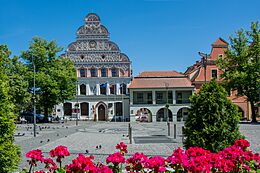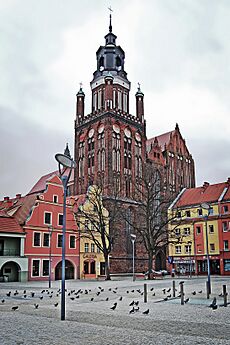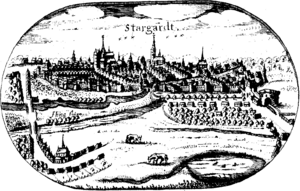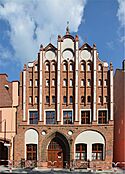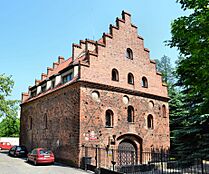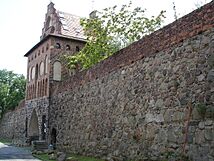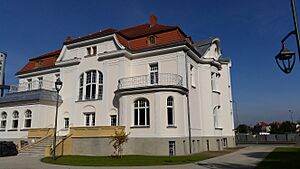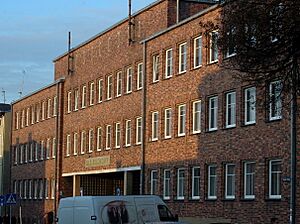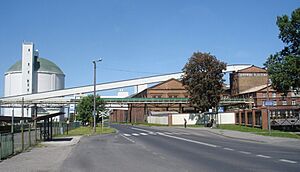Stargard facts for kids
Quick facts for kids
Stargard
|
|||||
|---|---|---|---|---|---|
|
From top, clockwise: City Hall, Pyrzyce Gate, St. Mary's Church
|
|||||
|
|||||
| Motto(s):
Stargard - Klejnot Pomorza
Stargard - Jewel of Pomerania |
|||||
| Country | |||||
| Voivodeship | |||||
| County | Stargard | ||||
| Gmina | Stargard (urban gmina) | ||||
| Established | 8th century | ||||
| First mentioned | 1124 | ||||
| City rights | 1243 | ||||
| Area | |||||
| • Total | 48.1 km2 (18.6 sq mi) | ||||
| Elevation | 20 m (70 ft) | ||||
| Population
(31 December 2021)
|
|||||
| • Total | 67,293 |
||||
| Time zone | UTC+1 (CET) | ||||
| • Summer (DST) | UTC+2 (CEST) | ||||
| Postal code |
73-100
to 73-110 |
||||
| Area code(s) | +48 91 | ||||
| Car plates | ZST | ||||
| Website | http://www.stargard.pl | ||||
Stargard is a city in northwestern Poland. It is located in the West Pomeranian Voivodeship. In 2021, about 67,293 people lived there. The city is built on the Ina River. Stargard is an important place for trains. It is the second biggest city in the area around Szczecin.
Contents
What's in a Name?
The name of the city, Stargard, comes from the Pomeranian language. This language is still spoken by the Kashubs. In their language, stari means old and gard or gôrd means town or city. So, Stargard means "old town."
Some experts think the name might come from an older language called Proto-Norse. In that language, starn means star and gate means gate.
A Look at Stargard's Past
Early Beginnings
Stargard started as a small settlement around the 8th century. In 967, it became part of the new country of Poland. This was under the first Polish rulers, the Piast dynasty.
The city was first written about in 1124. A church was built in 1140. Stargard officially became a city in 1243. It received special "city rights" from Barnim I, Duke of Pomerania.
Stargard grew to be a very important trading city in the Duchy of Pomerania. This was a region that had separated from Poland. By 1283, the city even had its own port on the Ina River. Strong city walls were built in the 13th century and made even bigger later on. In 1363, Stargard joined the Hanseatic League, which was a powerful group of trading cities.
Sometimes, cities competed with each other. Stargard had a trade rivalry with the nearby city of Szczecin. This led to a short war between them from 1454 to 1464.
Later History
Stargard was part of the Duchy of Pomerania until 1637. During the Thirty Years' War, a big war in Europe, the city was captured many times. It was taken by Sweden in 1630. Then, soldiers from the Holy Roman Empire tried to take it. The Swedish commander even set fire to parts of the city to stop them.
The city was captured and recaptured many times by different armies. Because of the war, about 75% of the people living in Stargard died or moved away.
After the war, in 1653, Stargard became part of Brandenburg-Prussia. In 1701, it became part of the Kingdom of Prussia. Later, in 1871, it joined the German Empire.
During World War I, from 1914 to 1918, a prisoner-of-war camp was set up in Stargard. About 50,000 prisoners were held there. These prisoners came from many countries, including Russia, France, Belgium, America, and England.
Stargard During World War II
In 1939, when World War II began, a large prisoner-of-war camp called Stalag II-D was created near Stargard. At first, Polish soldiers and civilians were held there. Later, soldiers from France, the Netherlands, Belgium, Yugoslavia, and the Soviet Union were also imprisoned. Thousands of Canadians captured in 1942 were also held here.
Prisoners were treated differently based on where they came from. For example, Polish, African, Arab, Jewish, and Soviet prisoners were treated much worse. There were also places where people were forced to work. The Polish resistance movement, called the Home Army, was active in Stargard.
In February 1945, near the end of the war, the people of Stargard were told to leave by the Germans. This was because the Soviet army was getting close.
After World War II, Stargard became part of Poland again. This was decided at the Potsdam Conference. Polish officials took over the city on March 23, 1945. Many new Polish residents moved to Stargard. Some of them had to leave their homes in eastern Poland, which was taken by the Soviet Union.
Stargard After the War
In 1950, the city's name was changed to Stargard Szczeciński. This was to help people tell it apart from another city called Starogard Gdański. The name was changed back to just Stargard on January 1, 2016.
In 1961, the nearby area of Kluczewo became part of Stargard. In 1979, the city experienced a flood. In 1993, Stargard celebrated its 750th birthday as a city.
Today, Stargard has industrial parks. These are special areas where many factories and businesses are located.
Famous Places and Buildings
During World War II, much of Stargard was destroyed by bombs. Over 75% of the city was ruined. But some important historical buildings have been rebuilt. These include St. Mary's Church and the old town hall. These new buildings are part of the European Route of Brick Gothic.
Here are some of the notable places you can see in Stargard:
- St. Mary's Church: This is a very old and famous church built in the 15th century. It is one of the largest brick churches in Europe. It is also a Historic Monument of Poland.
- St. John's Church: Another old church from the 15th century.
- Medieval walls and gates: Stargard still has parts of its old city walls, gates, and towers. These are also a Historic Monument of Poland.
- Brama Młyńska (The Mill Gate): Built in the 15th century, this is the only water gate in Poland that is still standing.
- Wałowa Gate: From the 15th century.
- Pyrzycka Gate: From the 13th century.
- Red Sea Tower (Baszta Morze Czerwone): Built in 1513.
- Weavers' Tower (Baszta Tkaczy): From the 15th century.
- White Head Tower (Baszta Białogłówka): From the 15th century.
- Old Gothic houses.
- Gothic Arsenal (Arsenał): An old building where weapons were stored.
Other interesting places include:
- Renaissance town hall: This building is known for its beautiful 16th-century design.
- Granary: A 16th-century building used for storing grain.
- The largest conciliation cross in Europe: This cross was built in 1542.
- Parks:
- Bolesław I the Brave Park (Park im. Bolesława Chrobrego): The oldest and biggest park in Stargard.
- Jagiellonian Park (Park Jagielloński).
- Old guardhouse: This building is now a museum.
- Holy Spirit church and Church of the Transfiguration.
- War cemetery: About 5,000 soldiers from many countries are buried here. They died during World War I and World War II.
- The 15th Meridian Monument (Pomnik 15. Południk): A monument marking a special line of longitude.
- Monuments to important Polish figures like Adam Mickiewicz and Juliusz Słowacki.
Sports in Stargard
Stargard is home to two main sports teams:
- Spójnia Stargard: This is a men's basketball team. They play in Poland's top basketball league. In 1997, they were the second-best team in the league.
- Błękitni Stargard: This is a men's association football (soccer) team. They are famous for reaching the semi-final of the Polish Cup in 2015.
People and Numbers
| Year | Inhabitants |
|---|---|
| 1618 | 12,000 |
| 1640 | 1,200 |
| 1688 | 3,600 |
| 1720 | 400 |
| 1740 | 5,529 |
| 1782 | 5,612 |
| 1786 | 6,243 |
| 1794 | 5,971 |
| 1812 | 8,900 |
| 1816 | 8,042 |
| 1831 | 9,907 |
| 1843 | 11,192 |
| 1852 | 12,473 |
| 1861 | 14,168 |
| 1875 | 20,173 |
| 1885 | 22,112 |
| 1900 | 26,858 |
| 1905 | 26,907 |
| 1910 | 27,551 |
| 1913 | 28,000 |
| 1929 | 34,600 |
| 1933 | 35,773 |
| 1939 | 39,760 |
| 1945 | 2,870 |
| 1950 | 20,684 |
| 1960 | 33,650 |
| 1970 | 44,460 |
| 1980 | 59,227 |
| 1990 | 71,000 |
| 1995 | 72,254 |
Famous People from Stargard
Many interesting people have come from Stargard, including:
- Karl August Ferdinand von Borcke (1776–1830), a Prussian general.
- Oscar Levy (1867–1946), a writer.
- Werner von Blomberg (1878–1946), a general.
- Hans-Joachim von Merkatz (1905–1982), a German government minister.
- Claus Biederstaedt (1928-2020), an actor.
- Peter Karow (born 1940), an entrepreneur.
- Carlo von Tiedemann (born 1943), a television presenter.
- Ewa Kasprzyk (born 1957), an actress.
- Margaret (born 1991), a singer-songwriter.
Stargard Around the World
Stargard has "twin towns" or "sister cities" in other countries. This means they have special friendly relationships.
|
Stargard in Stories
In a science fiction book series called The Cross Time Engineer, the main character pretends to be from Stargard. He does this to hide that he can travel through time!
See also
 In Spanish: Stargard para niños
In Spanish: Stargard para niños


